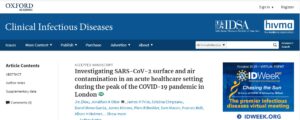A new study was published in Clinical Infectious Diseases exploring the extent and magnitude of hospital surface and air contamination with SARS-CoV-2 during the (first!) peak of COVID-19 in London.
Jon Otter, Clean Hospitals Research Director, is providing back-ground information through his reflectionsipc.com blog post.
The bottom line is that the study identified pretty extensive surface and air contamination with SARS-CoV-2 RNA but did not culture viable virus. The conclusion is that this highlights the potential role of contaminated surfaces and air in the spread of SARS-CoV-2.
DOWNLOAD THE OFFICIAL PUBLICATION HERE
Abstract
“We performed this prospective cross-sectional observational study in a multi-site London
hospital. Air and surface samples were collected from seven clinical areas, occupied by patients with
COVID-19, and a public area of the hospital. Three or four 1.0 m3
air samples were collected in each
area using an active air sampler. Surface samples were collected by swabbing items in the
immediate vicinity of each air sample. SARS-CoV-2 was detected by RT-qPCR and viral culture; the
limit of detection for culturing SARS-CoV-2 from surfaces was determined.
Viral RNA was detected on 114/218 (52.3%) of surfaces and 14/31 (38.7%) air samples but
no virus was cultured. The proportion of surface samples contaminated with viral RNA varied by
item sampled and by clinical area. Viral RNA was detected on surfaces and in air in public areas of
the hospital but was more likely to be found in areas immediately occupied by COVID-19 patients
than in other areas (67/105 (63.8%) vs. 29/64 (45.3%) (odds ratio 0.5, 95% confidence interval 0.2-
0.9, p=0.025, Chi squared test)). The high PCR Ct value for all samples (>30) indicated that the virus
would not be culturable.
Our findings of extensive viral RNA contamination of surfaces and air across a range of
acute healthcare settings in the absence of cultured virus underlines the potential risk from
environmental contamination in managing COVID-19, and the need for effective use of PPE, physical
distancing, and hand/surface hygiene.”
Clinical Infectious Diseases, ciaa905, https://doi.org/10.1093/cid/ciaa905


